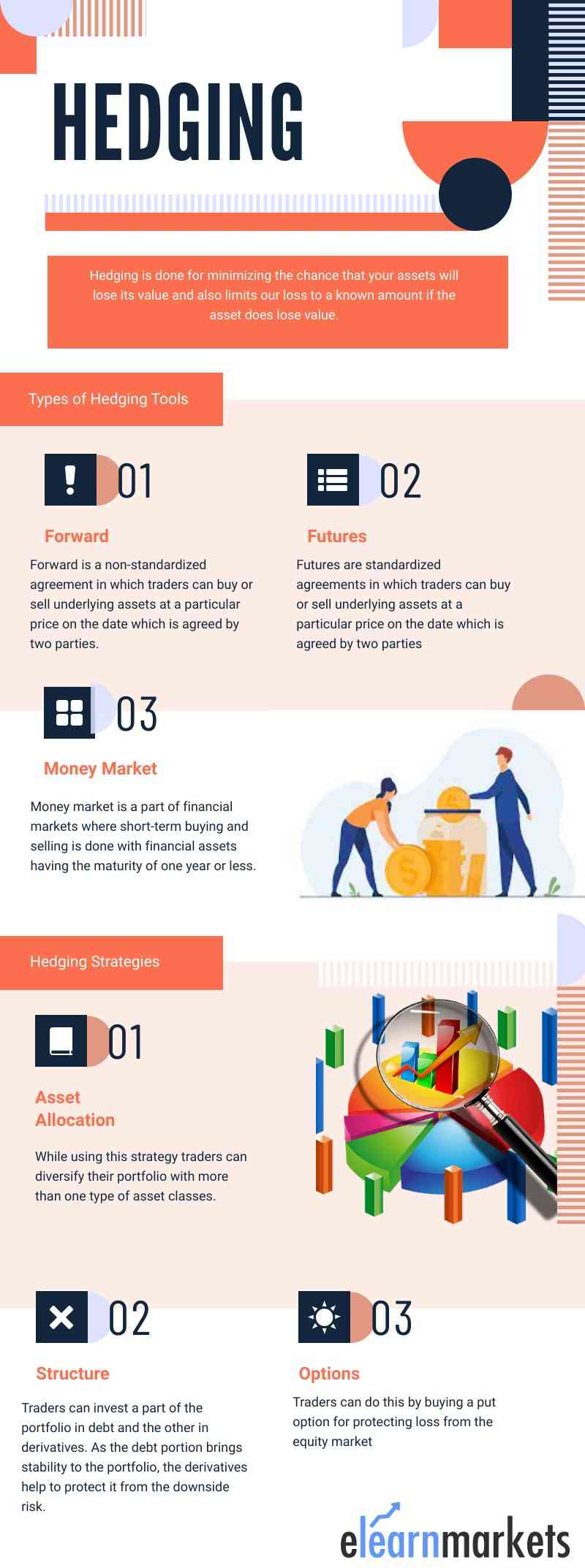A hedge is an investment which protects our finances from a risky situation.
It is done for minimizing the chance that your assets will lose its value and also limits our loss to a known amount if the asset does lose value.
Hedging in finance is a risk management strategy which helps us with reducing the risk of uncertainties.
It helps to limit our losses arising because of unknown ups or downs in the price of the investment.
This risk management strategy is followed by investors in the stock market for safeguarding their investments from losses.
Let us discuss how we use hedging in offsetting potential losses in the stock market:
What is Hedging?
A hedge is an investment which is made to reduce the risk of adverse price movements in an asset. In other terms, a hedge involves taking an offsetting or opposite position in a related security.
For example, if we have an open position in the stock which is trading at Rs.100, but due to some negative news in the stock the prices have fallen down. We can take a short position in the same stock in the derivatives market, to offset the loss which we incurred when we had a buy position in the stock.

Why do Investors hedge?
The main purpose of hedging is to limit the losses which may incur when the prices of the assets move in the opposite direction.
Hedging also helps in offsetting the risk of adverse price movements in an asset.
Investors in the stock market can minimize their losses from the equity market with the help of hedging.
Tools for Hedging:
Derivatives:
Derivatives are an effective hedging tool against their underlying assets, as the relationship between the two is defined.
Traders can use derivatives for setting up a trading strategy where the loss for one investment is offset by a gain in a comparable derivative.
Derivatives are financial contracts which derive their value from an underlying real asset, such as a stock, commodity, currency etc.
An option is a type of derivative which gives you the right but not an obligation to buy or sell a stock at a specified price within a particular time.
How to use Derivatives as a hedging tool ?
Let us discuss how derivatives can be used a hedging tool:
For instance, you bought stock and thought that the price would go up but wanted to protect against the loss if the price moves down.
In this case, we can hedge that risk with a put option. For a small premium, we can buy the right to sell the stock at the same price.
If the price of the stock falls, then we can exercise put and make back the money we just invested minus the premium.
We would have lost the entire investment if we didn’t use the put option as a hedging tool.
Diversification is also another hedging tool. In this, we own an assortment of assets that don’t rise or fall simultaneously.
If one asset collapses, then we don’t lose everything. For example, most people own bonds to offset the risk of stock ownership.
When stock prices fall, then the bond values increase and vice versa.

Types of Hedging:
Below are the types of hedging tools:
1. Forward:
Forward is a non-standardized agreement in which traders can buy or sell underlying assets at a particular price on the date which is agreed by two parties. It involves various contracts such as forward exchange contracts for currencies, commodities, etc.
2. Futures:
Futures are standardized agreements in which traders can buy or sell underlying assets at a particular price on the date which is agreed by two parties. It involves various contracts such as currencies, commodities, future contracts, etc.
3. Money Market:
Money market is a part of financial markets where short-term buying and selling is done with financial assets having the maturity of one year or less such as short-term loans, borrowing, selling and lending with a maturity of one year or more.
Strategies of Hedging:
Below are the strategies of hedging which traders can use:
- Asset Allocation: While using this strategy traders can diversify their portfolio with more than one type of asset classes. For instance, traders can invest 60% in equity and the rest 40% in other more stable assets, for creating a balanced portfolio.
- Structure: Traders can invest a part of the portfolio in debt and the other in derivatives. As the debt portion brings stability to the portfolio, the derivatives help to protect it from the downside risk.
- Options: Traders can do this by buying a put option for protecting loss from the equity market as discussed above.
Advantages of Hedging:
Here are the benefits of using this strategy:
- Hedging is mainly used for locking the profit.
- It helps the traders to limits losses to a great extent
- It facilitates investors to invest in other types of asset classes, which increases liquidity.
- It helps the traders to save time as he is not required to monitor his portfolio with daily market volatility.
- It helps the trader in giving protection against price changes, currency exchange rate changes, inflation, interest rate changes, etc.
- In hedging, using options helps the traders in getting an opportunity to practice complex options trading strategies for maximizing their return.
Disadvantages of Hedging:
Below are the disadvantages of Hedging:
- Hedging involves cost which can eat up the profit.
- Risk and reward are often proportional, so reducing risk means reducing profits.
- For a day trader, hedging is a difficult strategy to implement
- Trading of options or futures requires more capital or balance.
- Hedging is a precise trading strategy, traders require good trading skills and experience to implement it.
Key Takeaways:
- A hedge is an investment which protects our finances from a risky situation.
- The main purpose of hedging is to limit the losses which may incur when the prices of the assets move in the opposite direction.
- Traders can use derivatives for setting up a trading strategy where the loss for one investment is offset by a gain in a comparable derivative.
- Diversification is also another hedging tool. In this, we own an assortment of assets that don’t rise or fall simultaneously
Frequently Asked Questions :
Q. Can I hedge with small capital?
Yes, you can hedge with a small capital, for example- you can diversify your portfolio with 70% in equity and
Q. How to hedge stocks whose Future contracts/ Option contracts are not available?
You can use other hedging strategies like asset allocation and money market instruments as we have discussed above when the options or the futures of that particular stock are not available.
You can also visit web.stockedge.com is a unique platform, which is 100% focused on research and analytics.
Happy Investing!











